The Breather Bags Market is estimated to be valued at USD 663.6 million in 2025 and is projected to reach USD 1101.7 million by 2035, registering a compound annual growth rate (CAGR) of 5.2% over the forecast period.
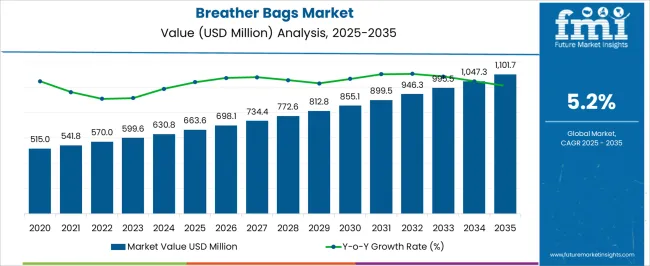
| Metric | Value |
|---|---|
| Breather Bags Market Estimated Value in (2025E) | USD 663.6 million |
| Breather Bags Market Forecast Value in (2035F) | USD 1101.7 million |
| Forecast CAGR (2025 to 2035) | 5.2% |
The breather bags market is gaining momentum as regulatory compliance, contamination control, and sterile packaging requirements become central across healthcare and life sciences industries. Growing focus on aseptic packaging in pharmaceuticals and laboratory settings has expanded demand for breather bags that provide barrier protection while enabling controlled airflow. Manufacturers are increasingly investing in material innovation to improve breathability, strength, and puncture resistance without compromising sterility.
The rise in single-use medical supplies and the global shift toward disposable medical packaging formats are accelerating the adoption of flexible yet functional breather bags. Environmental concerns have also prompted efforts to develop recyclable and low-footprint materials, especially in high-volume application settings.
As global pharmaceutical production expands and biologics manufacturing becomes more widespread, breather bags are expected to play a crucial role in product integrity and contamination control throughout logistics, storage, and clinical usage. Growth opportunities lie in expanding cleanroom applications and refining material blends to meet evolving industry certifications and operational demands.
The market is segmented by Applications, Product Type, and Material and region. By Applications, the market is divided into Pharmaceuticals, Medical Devices, Aquatic Livestock, Hospital Sterilization, Cleaning Units, Sterilized Supplies, Surgical Packs, and Anesthesia Machines. In terms of Product Type, the market is classified into Disposable Breather Bags and Reusable Breather Bags. Based on Material, the market is segmented into High-Density Polyethylene (HDPE), Polypropylene (PP), Vinyl, Tyvek, Latex, Polyester, and Vegetable Produce. Regionally, the market is classified into North America, Latin America, Western Europe, Eastern Europe, Balkan & Baltic Countries, Russia & Belarus, Central Asia, East Asia, South Asia & Pacific, and the Middle East & Africa.
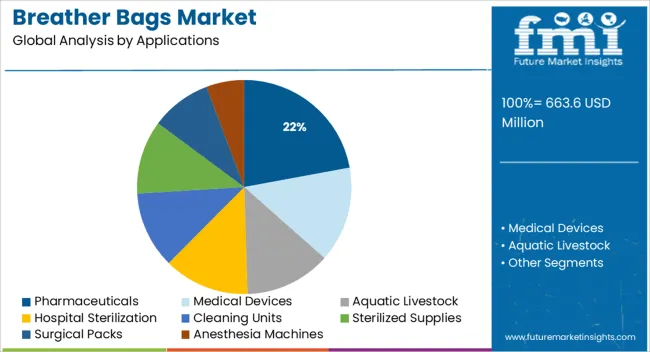
The pharmaceuticals segment is projected to hold 22.1% of total market revenue by 2025 within the application category, making it one of the primary end users of breather bags. This dominance is being supported by stringent sterility requirements and packaging integrity needs throughout drug manufacturing and distribution.
Breather bags are favored for their ability to allow gas exchange while protecting contents from particulate contamination, making them vital in primary and secondary pharmaceutical packaging. Adoption has been driven by the rise in biologics and sensitive formulations that require protective packaging during production, storage, and transport.
The global expansion of pharmaceutical manufacturing and the emphasis on GMP-compliant packaging solutions have reinforced the role of breather bags in cleanroom environments and quality-controlled logistics. Additionally, increased outsourcing to contract manufacturing organizations has further elevated the demand for standardized, disposable protective packaging options in the pharmaceutical space.
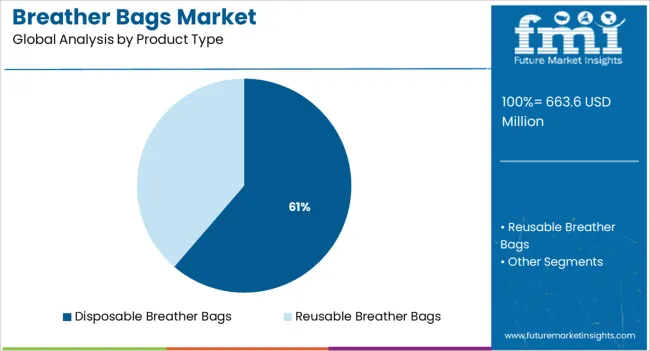
The disposable breather bags segment is anticipated to account for 61.3% of market revenue by 2025 in the product type category, positioning it as the leading product format. This segment’s growth is being fueled by the healthcare sector’s increased reliance on sterile, single-use packaging solutions that mitigate cross-contamination risks.
The convenience of disposability coupled with reduced cleaning and validation procedures makes these bags highly attractive for clinical, pharmaceutical, and laboratory applications. Growing adoption of lean manufacturing principles in life sciences and hospital operations has further promoted the shift toward disposable options that ensure consistent performance and regulatory compliance.
These bags are also cost-effective at scale and compatible with automation systems used in high-throughput environments. As global regulatory bodies emphasize hygienic packaging practices, disposable breather bags continue to gain preference across sectors seeking sterile and operationally efficient packaging.
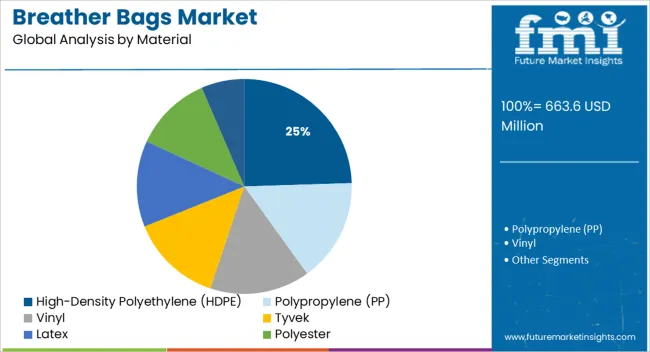
High-density polyethylene is expected to contribute 24.5% of total market revenue in 2025 within the material segment, positioning it as a top material choice for breather bag production. Its popularity is attributed to a strong balance of durability, chemical resistance, and breathability that aligns well with healthcare and laboratory packaging needs.
HDPE offers an effective moisture and microbial barrier while maintaining structural flexibility, which is essential for bags used in sterile processing and clinical storage. Its compatibility with gamma and ethylene oxide sterilization methods further supports its widespread adoption.
In addition to its physical properties, HDPE is also considered a more environmentally manageable plastic due to its recyclability and lower carbon footprint in production compared to other polymers. Manufacturers have favored HDPE for its processability and ability to maintain integrity in fluctuating environmental conditions, which continues to support its dominant position in the breather bags material category.
Rapid pace of design and technological innovation in the packaging industry has led to the development of packaging products that specifically cater to industry needs. Breather bags are one such innovative packaging product specifically addressing the issue of transporting aquatic livestock among host of other industry requirements.
The market for breather bags is characterized by plastic material bags being supplied for the packaging and transportation of pharmaceutical products, aquatic livestock and food for aquatic livestock. Breather bags have wider scope in the pharmaceutical sector as the market is growing at a substantial rate and is expected to face a major transformation.
Breather bags functions in a respirational manner by aligning inner atmosphere of the packaging as per the air components required by the packaged material. Breather bags are made of special design films that provide micro-porosity characteristics to the bag which allow constant passage of gases such as carbon di oxide and oxygen.
These breather bags have the advantage of gas exchange through its walls, and the exit rate of carbon-dioxide compared to the oxygen is four times faster thus making it economical for the aquatic livestock transporters. These micro-porosity properties of breather bags make them an effective substitute for any other packaging material including thermoform and corrugated paperboard.
Key factor supporting the growth of breather bags market is the molecular realignment property of the bag’s material (ethylene), wherein the molecules realign in such a way that they either reduce the pore size or reseal it. Pressure maintenance is another factor in the growth of breather bags market as when there is a different pressure around the bag it equalizes it without inducing any effect on its inner environment.
Second generation breather bags with more resistance, better clarity and better sealing properties also contribute to the growth of breather bags market. The advancement of encasing the embryonated chicken eggs (ECE) inoculate with various viruses also present itself a factor in the growth of breather bags market.
However, the problem of quicker fouling of water by fish waste or dead fish and transportation of those aquatic animals like betas, aquatic frog and snails which require direct air, hinders the growth of the breather bags market. Moreover, the seeping of bags and spillage while opening the bag also creates a barrier for the breather bags market.
The growing trend of transporting marine life owing to less amount of the water required while transporting makes breather bags an affordable solution.
Geographically, the breather bags market is segmented into North America, Asia-Pacific, Europe, Latin America, and Middle East & Africa. North America is dominant regarding revenue contribution to the market and expected to grow at the same rate.
The growth in the pharmaceutical industry is expected to dominate the market share of breather bags market as the demand is anticipated to increase in the Asia Pacific region over the forecasted period. Manufacturers are also expected to invest in the Latin American region due to economic revolution and rise in standard of living.
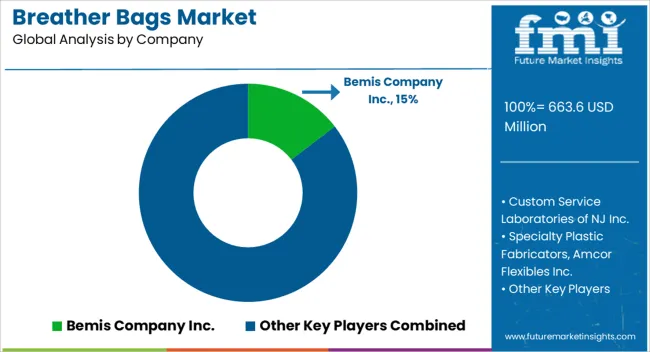
Some of the key players are Bemis Company Inc., Custom Service Laboratories of NJ Inc., Specialty Plastic Fabricators, Amcor Flexibles Inc., BFM Global Ltd, Kordon LLC, KNF Corporation, Fisher Container Corp., Nolato Torekov AB and Precision Dippings Manufacturers Ltd.
The report offers an accurate evaluation of the market through detailed qualitative insights and verifiable projections about market size. The projections presented in the report have been derived using proven research methodologies and assumptions.
The breather bag market is segmented on the basis of product type, material and applications.
The global breather bags market is estimated to be valued at USD 663.6 million in 2025.
The market size for the breather bags market is projected to reach USD 1,101.7 million by 2035.
The breather bags market is expected to grow at a 5.2% CAGR between 2025 and 2035.
The key product types in breather bags market are pharmaceuticals, medical devices, aquatic livestock, hospital sterilization, cleaning units, sterilized supplies, surgical packs and anesthesia machines.
In terms of product type, disposable breather bags segment to command 61.3% share in the breather bags market in 2025.






Our Research Products

The "Full Research Suite" delivers actionable market intel, deep dives on markets or technologies, so clients act faster, cut risk, and unlock growth.

The Leaderboard benchmarks and ranks top vendors, classifying them as Established Leaders, Leading Challengers, or Disruptors & Challengers.

Locates where complements amplify value and substitutes erode it, forecasting net impact by horizon

We deliver granular, decision-grade intel: market sizing, 5-year forecasts, pricing, adoption, usage, revenue, and operational KPIs—plus competitor tracking, regulation, and value chains—across 60 countries broadly.

Spot the shifts before they hit your P&L. We track inflection points, adoption curves, pricing moves, and ecosystem plays to show where demand is heading, why it is changing, and what to do next across high-growth markets and disruptive tech

Real-time reads of user behavior. We track shifting priorities, perceptions of today’s and next-gen services, and provider experience, then pace how fast tech moves from trial to adoption, blending buyer, consumer, and channel inputs with social signals (#WhySwitch, #UX).

Partner with our analyst team to build a custom report designed around your business priorities. From analysing market trends to assessing competitors or crafting bespoke datasets, we tailor insights to your needs.
Supplier Intelligence
Discovery & Profiling
Capacity & Footprint
Performance & Risk
Compliance & Governance
Commercial Readiness
Who Supplies Whom
Scorecards & Shortlists
Playbooks & Docs
Category Intelligence
Definition & Scope
Demand & Use Cases
Cost Drivers
Market Structure
Supply Chain Map
Trade & Policy
Operating Norms
Deliverables
Buyer Intelligence
Account Basics
Spend & Scope
Procurement Model
Vendor Requirements
Terms & Policies
Entry Strategy
Pain Points & Triggers
Outputs
Pricing Analysis
Benchmarks
Trends
Should-Cost
Indexation
Landed Cost
Commercial Terms
Deliverables
Brand Analysis
Positioning & Value Prop
Share & Presence
Customer Evidence
Go-to-Market
Digital & Reputation
Compliance & Trust
KPIs & Gaps
Outputs
Full Research Suite comprises of:
Market outlook & trends analysis
Interviews & case studies
Strategic recommendations
Vendor profiles & capabilities analysis
5-year forecasts
8 regions and 60+ country-level data splits
Market segment data splits
12 months of continuous data updates
DELIVERED AS:
PDF EXCEL ONLINE
Oil Breather Tank Market Growth - Trends & Forecast 2025 to 2035
Dehydrating Breather Market Size and Share Forecast Outlook 2025 to 2035
Polybags Market Size and Share Forecast Outlook 2025 to 2035
Net Bags Market
VCI Bags Market
Sandbags Market
Leno Bags Market Size and Share Forecast Outlook 2025 to 2035
Silo bags Market Size and Share Forecast Outlook 2025 to 2035
Food Bags Market Share, Size, and Trend Analysis for 2025 to 2035
Competitive Breakdown of Silo Bag Manufacturers
Paper Bags Market Size and Share Forecast Outlook 2025 to 2035
Jumbo Bags Market Size and Share Forecast Outlook 2025 to 2035
Blood Bags Market Size and Share Forecast Outlook 2025 to 2035
Craft Bags Market Growth, Trends, Forecast 2025 to 2035
Market Share Breakdown of Craft Bags Manufacturers
Competitive Breakdown of Paper Bags Providers
Market Share Analysis of Jumbo Bags & Key Players
Grout Bags Market Demand & Construction Industry Trends 2024 to 2034
Sugar Bags Market
Cotton Bags Market Size and Share Forecast Outlook 2025 to 2035

Thank you!
You will receive an email from our Business Development Manager. Please be sure to check your SPAM/JUNK folder too.
Chat With
MaRIA